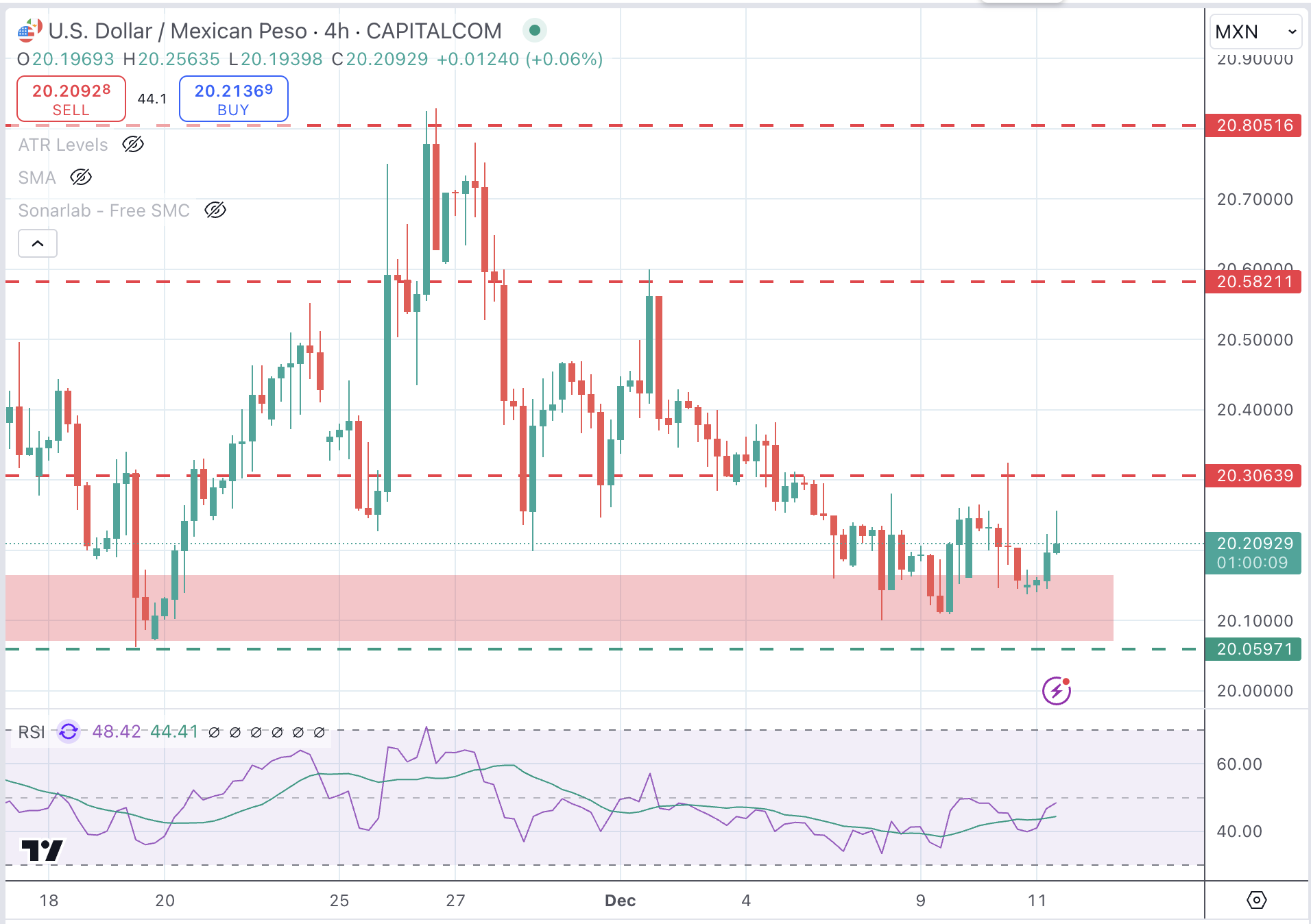- The US Dollar is gaining momentum with investors wary of risk ahead of the release of US CPI data for November.
- US inflation is expected to have ticked up above the Fed’s 2% target.
- Technically, the USD/MXN maintains the short-term negative trend intact.
The Mexican Peso (MXN) has been capped again near the 20.00 level and is pulling back on Wednesday. The US Dollar (USD) appreciates across the board buoyed by higher US Treasury yields as traders are growing wary of risk heading into the release of US November’s Consumer Prices Index (CPI) data.
US inflation is expected to have ticked up slightly at levels above the Fed’s 2% target rate. This, coupled with expectations that Donald Trump’s government will implement inflationary policies, is likely to limit the scope of the Federal Reserve’s (Fed) easing cycle.
Economic data from Mexico revealed that consumer confidence deteriorated in November to its weakest reading since September. On Monday, November’s CPI cooled beyond expectations, which endorses the view that the Bank of Mexico will cut interest rates again next week.
Daily digest market movers: Mexican Peso hesitates against a stronger US Dollar
- US CPI inflation is expected to have accelerated at a 0.3% pace in November and 2.7% from the same month last year from 0.2% and 2.6%, respectively, in October.
- The US core CPI, more relevant regarding monetary policy expectations, is seen growing steadily at 0.3% on the month and 3.3% year on year.
- Futures markets are now pricing an 85% chance that the Fed will cut interest rates by 25 basis points in December, up from below 70% last week, according to data from the CME Group’s Fed Watch tool.
- US Treasury Secretary and former Fed Chair, Janet Yellen, warned at a Wall Street Journal’s Summit that Donald Trump’s sweeping tariffs could “significantly raise costs to households” and derail progress on inflation.
- Data released on Tuesday revealed that Mexico’s Consumer Confidence dropped 1.5 points in November, to 47.4 points. The report reflected a deterioration in the households’ and the country’s economic expectations in the next 12 months.
- Mexico’s CPI eased at a 4.55% pace in the last twelve months to November, from 4.76% in the previous month. The market was expecting a 4.59% reading.
- Likewise, the core CPI dropped to 3.58% year-on-year from 3.8%, below the market consensus of a 3.6% reading.
- These figures boost hopes that the Bank of Mexico will cut rates by 25 bps for the fourth consecutive time after their December 19 meeting.
Mexican Peso technical outlook: USD/MXN has strong support at 20.00
The USD/MXN pair remains steady above the 20.00 support area, with upside attempts limited below the December 5 high at the 20.30 area so far.
The technical picture shows the US Dollar is building up heading into the release of the US CPI report. The 4-hour Relative Strength Index (RSI) has popped up above the 50 level, suggesting an incipient bullish momentum. The broader perspective, however, remains bearish with the double top at 20.80 suggesting the possibility of a deeper correction.
Immediate resistance is at the mentioned December 5 high at 20.30, ahead of the December 2 high at 20.60 and November’s peak at 20.80.
On the downside, the 20.00 psychological level is the neckline of the mentioned double top ahead of November’s low at 19.75.
USD/MXN 4-hour Chart

Inflation FAQs
Inflation measures the rise in the price of a representative basket of goods and services. Headline inflation is usually expressed as a percentage change on a month-on-month (MoM) and year-on-year (YoY) basis. Core inflation excludes more volatile elements such as food and fuel which can fluctuate because of geopolitical and seasonal factors. Core inflation is the figure economists focus on and is the level targeted by central banks, which are mandated to keep inflation at a manageable level, usually around 2%.
The Consumer Price Index (CPI) measures the change in prices of a basket of goods and services over a period of time. It is usually expressed as a percentage change on a month-on-month (MoM) and year-on-year (YoY) basis. Core CPI is the figure targeted by central banks as it excludes volatile food and fuel inputs. When Core CPI rises above 2% it usually results in higher interest rates and vice versa when it falls below 2%. Since higher interest rates are positive for a currency, higher inflation usually results in a stronger currency. The opposite is true when inflation falls.
Although it may seem counter-intuitive, high inflation in a country pushes up the value of its currency and vice versa for lower inflation. This is because the central bank will normally raise interest rates to combat the higher inflation, which attract more global capital inflows from investors looking for a lucrative place to park their money.
Formerly, Gold was the asset investors turned to in times of high inflation because it preserved its value, and whilst investors will often still buy Gold for its safe-haven properties in times of extreme market turmoil, this is not the case most of the time. This is because when inflation is high, central banks will put up interest rates to combat it. Higher interest rates are negative for Gold because they increase the opportunity-cost of holding Gold vis-a-vis an interest-bearing asset or placing the money in a cash deposit account. On the flipside, lower inflation tends to be positive for Gold as it brings interest rates down, making the bright metal a more viable investment alternative.

























